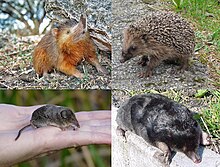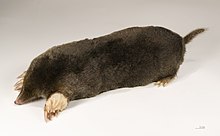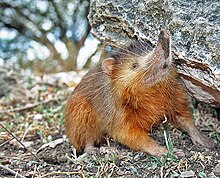에우리포티플라
Eulipotyphla| 에우리포티플라 범위: S P K N | |
|---|---|
 | |
| 왼쪽 위부터 시계방향 : 솔레노돈, 고슴도치,[a] 두더지, 랫드류 | |
| 과학적 분류 | |
| 왕국: | 애니멀리아 |
| 문: | 챠다타 |
| 클래스: | 젖꼭지 |
| 매그너 순서: | 볼로어테리아속 |
| 상위 순서: | 로라시아테리아 |
| 주문: | 에우리포티플라 Waddell et al., |
| 가족들 | |
| 동의어 | |
| 유인섹티보라 | |
포유류 계통 발생적 재건의 분자량 방법에 의해 제안되의 Eulipotyphla(는 뜻 /ˌjuːlɪpoʊˈtɪflə/,"진정으로 그리고 장님의 지방"[1])은 명령, 그리고now-invalid 다 계통 발생의 주문 Lipotyphla의laurasiatherian명이 아닌afrotherian 멤버는 그들만의 주문 Afros에(tenrecs, 황금 두더지,와 수달 뾰족 뒤쥐, 포함한다.ori즉, 리포티플라는 이전에 사용되었던 쓰레기통 분류군인 Envivora에서 많은 그룹을 제거함으로써 파생되었다.
Eulipotyphla는 고슴도치와 체조(Erinaceidae, 이전의 Erinaceomorpha목), 솔레노돈(Solenodonidae), 데스만, 두더지, 랫드류 같은 두더지(Talpidae)와 진정한 랫드류(Soricidae)로 구성되어 있다.진정한 랫드류, 탈피드, 솔레노돈은 이전에는 소리모르파(Soricomorpha)로 분류되었지만, 에리나시드가 랫드류의 자매군이기 때문에 측계통인 것으로 밝혀졌으며, 이들은 카르니보라목(고양이, 개, 곰, 스컹크, 오소리 등)[2][3][4]과 더 밀접하게 관련되어 있다.
그것은 Scrotifera의 자매 분류군이다; 그들은 함께 Laurasiatheria를 구성한다.
분류
- Eulipotyphla목(= '리포티플라' - Afrosoricida = 'Erinaceompha' + 'Soricompha)
Roca 등 및 Brace [3][10]등에 이은 현대 을리포티플란 관계의 가족 단위 분해도:
| 에우리포티플라 |
| ||||||||||||||||||||||||
이 나무 안에 있는 위쪽과 아래쪽 기저부 아군은 각각 [10]솔레노도노타 아목과 에린아세오타 아목이다.이 두 가지는 7200만-7400만년 전에 [10][5][6]갈라진 것으로 추정된다.Nesophontidae와 Solenodontidae는 약 57 Ma [10]전에 분리된 것으로 생각됩니다.탈피드 대 솔리시드 + 에리나시드, 솔리시드 대 에리나시드의 분할 시간은 각각 69 [11]Ma와 64 Ma로 추정되었습니다.
메모들
레퍼런스
- ^ Hassan, Mo (2009-10-11). "British Wildlife: N". The Disillusioned Taxonomist blog. Retrieved 2015-11-26.
- ^ Douady, C. J.; Chatelier, P. I.; Madsen, O.; de Jong, W. W.; Catzeflis, F.; Springer, M. S.; Stanhope, M. J. (October 2002). "Molecular phylogenetic evidence confirming the Eulipotyphla concept and in support of hedgehogs as the sister group to shrews". Molecular Phylogenetics and Evolution. 25 (1): 200–209. doi:10.1016/S1055-7903(02)00232-4. PMID 12383761.
- ^ a b Roca, A. L.; Bar-Gal, G. K.; Eizirik, E.; Helgen, K. M.; Maria, R.; Springer, M. S.; O'Brien, S. J.; Murphy, W. J. (2004-06-10). "Mesozoic origin for West Indian insectivores". Nature. 429 (6992): 649–651. Bibcode:2004Natur.429..649R. doi:10.1038/nature02597. PMID 15190349. S2CID 915633.
- ^ Bininda-Emonds, O. R. P.; Cardillo, M.; Jones, K. E.; MacPhee, R. D. E.; Beck, R. M. D.; Grenyer, R.; Price, S. A.; Vos, R. A.; Gittleman, J. L.; Purvis, A. (2007-03-29). "The delayed rise of present-day mammals". Nature. 446 (7135): 507–512. Bibcode:2007Natur.446..507B. doi:10.1038/nature05634. PMID 17392779. S2CID 4314965.
- ^ a b de Lazaro, Enrico (19 March 2018). "Solenodon Genome Sequenced". Sci-News.com. Retrieved 2019-06-23.
- ^ a b Grigorev, K.; Kliver, S.; Dobrynin, P.; Komissarov, A.; Wolfsberger, W.; Krasheninnikova, K.; Afanador-Hernández, Y. M.; Brandt, A. L.; Paulino, L. A.; Carreras, R.; Rodríguez, L. E.; Núñez, A.; Brandt, J. R.; Silva, F.; Hernández-Martich, J. D.; Majeske, A. J.; Antunes, A.; Roca, A. L.; O'Brien, S. J.; Martínez-Cruzado, J. C.; Oleksyk, T. K. (2018). "Innovative assembly strategy contributes to understanding the evolution and conservation genetics of the endangered Solenodon paradoxus from the island of Hispaniola". GigaScience. 7 (6): giy025. doi:10.1093/gigascience/giy025. PMC 6009670. PMID 29718205.
- ^ Kim, N.H.; Lim, S.J.; Chae, H.M.; Park, Y.C. (2017). "Complete mitochondrial genome of the Amur hedgehog Erinaceus amurensis (Erinaceidae) and higher phylogeny of the family Erinaceidae". Genetics and Molecular Research. 16 (1). doi:10.4238/gmr16019300. PMID 28198504.
- ^ Dubey, S.; Salamin, N.; Ohdachi, S.D.; Barrière, P.; Vogel, P. (2007). "Molecular phylogenetics of shrews (Mammalia: Soricidae) reveal timing of transcontinental colonizations". Molecular Phylogenetics and Evolution. 44 (1): 126–137. doi:10.1016/j.ympev.2006.12.002. PMID 17267241.
- ^ He, K.; Shinohara, A.; Helgen, K.M.; Springer, M.S.; Jiang, X.-L.; Campbell, K.L. (2017). "Talpid Mole Phylogeny Unites Shrew Moles and Illuminates Overlooked Cryptic Species Diversity". Molecular Biology and Evolution. 34 (1): 78–87. doi:10.1093/molbev/msw221. PMID 27795230.
- ^ a b c d Brace, S.; Thomas, J. A.; Dalén, L.; Burger, J.; MacPhee, R. D. E.; Barnes, I.; Turvey, S. T. (2016). "Evolutionary History of the Nesophontidae, the Last Unplaced Recent Mammal Family". Molecular Biology and Evolution. 33 (12): 3095–3103. doi:10.1093/molbev/msw186. PMID 27624716.
- ^ Springer, M. S.; Murphy, W. J.; Roca, A. L. (2018). "Appropriate fossil calibrations and tree constraints uphold the Mesozoic divergence of solenodons from other extant mammals". Molecular Phylogenetics and Evolution. 121: 158–165. doi:10.1016/j.ympev.2018.01.007. PMID 29331683.






